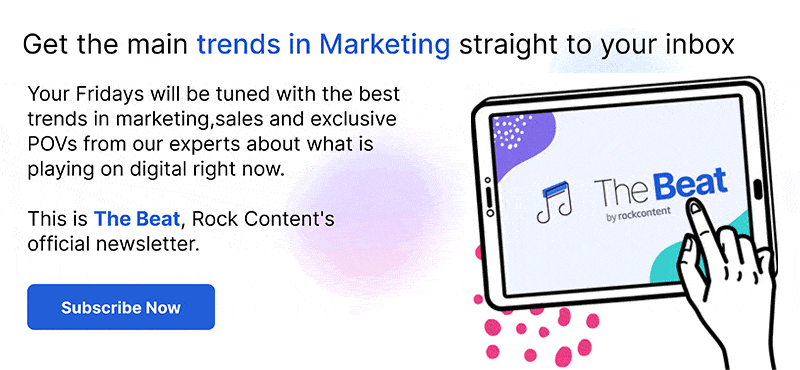Have you ever wondered how the Marketing world has evolved over time? From banners and other sources of offline marketing, to radio and TV insertions, phone calls and text messages, and then the internet with Digital Marketing.
Digital Marketing brings new ways to consume and create content. Blogs brought new ways to write texts and deliver articles, video platforms made it possible to find and post various formats of audiovisual content and social media allows people to share short texts and images.
And now interactive content appears as a new format to differentiate your brand and make it more memorable to your audience. In this article we’ll see some statistics about interactive content, the main formats and how it makes Digital Marketing more interesting.
At the end of the article, I’ll share a link to a free course about interactive content strategy so you can get started with bringing real results to your brand!
Interactive content as a new step for Digital Marketing
Businesses see Digital Marketing as a road to lead their strategies. It is truly an environment where companies can take advantage of and reach more people. The thing is: anyone is able to produce content and share it on digital platforms. How can companies stand out in such a noisy reality full of marketers, authors, journalists and new content popping up every second?
It is a fact that brands need to have a dedicated attention towards Marketing strategies, so the way businesses use digital platforms is not the same as how people use them.
It requires the right professionals and softwares that will give the support needed to conduct structured, constant and consistent strategies, whether if it is a large enterprise or a small business, as mentioned by Forbes.
Differentiating your brand’s content from the ones available all over the internet, including your competitors, gives you a step ahead to get closer to the audience. Providing memorable content experiences can be the turning point to be on top of your potential customers’ mind.
This information has been proved by marketers, as 88% of the professionals who responded to a survey agree that interactive content plays an important role in differentiating their brands.
Taking into consideration that we are all users, it is easy to define what our preferred format is. Personalized experiences, like interactive content, makes us feel closer to the brands, building stronger connections and increasing the likelihood of making a purchase for example.
Many brands already do so, such as Apple with its iPhone pages, as I mentioned in this post.
It is even possible to dare and mention that interactive content is the next generation of content, especially when it comes to brands. Reading only long texts, PDFs or any other static content makes it more difficult to engage with the subject, and so too with the brand.
79% of marketers surveyed by the Content Marketing Institute (CMI) stated that interactive content improves messaging retention. The survey also shows that interactive content delivers 52.6% more engagement, reinforcing that people are really keen on this format.
Interactive content formats and possibilities
As mentioned, a Marketing strategy needs to be structured and consistent. It means that all the moves need to be connected to the business goals. Interactive Content is able to give an important push with this if we better understand how it works and what it can help us accomplish.
Here is a short list of possibilities (you can take a deeper look in this Interactive Content Guide):
- Engagement
- Increase average time on page
- Educate Consumers
- Boost CTR (Click through rate)
- Lead Generation
- Backlinks
- Collect data
You may be wondering what the content formats are that enable the creation of these connections in your strategy. It is interesting to notice how interactive content is one of the most versatile ways to deliver a rich, memorable experience to the audience
What matters the most is how your brand is going to make the information easy to digest in a creative way. With that in mind, you can start exploring it by creating:
- Assessments
- Quizzes
- Landing Pages
- Infographics
- Calculators
- eBooks
- White Papers
- Lookbooks and Tours
- Solution Finders
- Maps
In order to create these assets in a scalable way that allows marketers to be free to choose how to do and when to apply an interactive piece, it is important to have a good interactive content platform.
A code-free system with good templates will drive agility to the process and give professionals the autonomy and flexibility they need to focus on what matters most for them.
Building a scalable content strategy doesn’t necessarily mean that you need to create new content at any cost, giving up on the quality of it. If a business already has rich materials that are important to generate awareness, educate, nurture or convert leads, it can have its powers increased by becoming a high-value interactive experience using the right tools.
Another important point to keep in mind that also helps marketers is the value of the information that interactive experiences can provide. The right integrations with a CRM for example, will help in building a resourceful environment. Then, the possibility of testing and learning new things from your audience will give you new insights into how to deliver what they really want from you and increase your success.
Free Course: Interactive Content Experience Strategy
If you are looking for a way to learn how to take advantage of all the benefits that interactive content is able to offer, take a look at Rock University’s free course about Interactive Content Strategy. Learn all the steps to create memorable experiences that will take your Marketing results to the next level!








